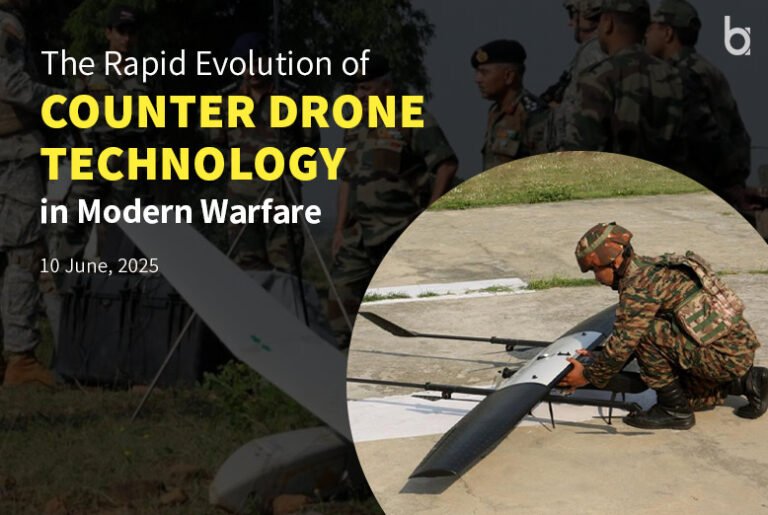Business APAC
June 10, 2025
The defining image of modern warfare is no longer just the tank or the fighter jet; it’s the persistent, low hum of a small drone. In conflicts across the globe, commercially available quadcopters and cheap, purpose-built unmanned aerial vehicles (UAVs) have become the weapon of choice.
These systems, costing anywhere from a few hundred to a few thousand dollars, are serving as potent force multipliers, achieving strategic objectives while blurring the lines between military-grade and hobbyist technologies. This has triggered a desperate and frantic global scramble for effective counter drone technology, creating a new, high-stakes arms race where the defense can cost a thousand times more than the attack.
The Battlefield’s New Apex Predator
The war in Ukraine has served as a stark, real-world laboratory, demonstrating the devastating effectiveness of low-cost drones. Small, off-the-shelf models are routinely modified to drop grenades on armored vehicles, while larger, fixed-wing drones act as precision-guided munitions, striking critical infrastructure hundreds of kilometers behind enemy lines. This new reality has fundamentally altered battlefield dynamics.
The widespread availability of low-cost aerial technology has led to a significant shift in modern warfare. Small units can now access surveillance, targeting, and precision-strike capabilities for less than the cost of standard infantry equipment. This development poses an asymmetric threat that traditional military forces are struggling to counter. As a result, developing and deploying scalable counter-drone solutions has become an urgent priority for defense organizations worldwide.
This shift means that every soldier, vehicle, and installation is now a potential target, not just from sophisticated military assets, but from a threat that can be bought online and launched from a nearby field.
A Multi-Billion Dollar Response
In response, a specialized and rapidly growing industry has emerged, focused entirely on detecting, tracking, and neutralizing hostile drones. The solutions range from brute-force kinetics to sophisticated electronic warfare. These systems broadly fall into three categories:
- Electronic “Soft Kill” Systems: These technologies focus on disabling the drone without physically destroying it. This includes powerful radio-frequency jammers that sever the link between the drone and its operator, as well as GPS “spoofers” that hijack the drone’s navigation system, forcing it to land or fly harmlessly away.
- Kinetic “Hard Kill” Systems: This involves physically destroying the drone. Solutions range from traditional guns guided by advanced radar to highly specialized interceptor drones that launch nets or slam into the target. More advanced systems include high-energy lasers and high-power microwave weapons that can fry a drone’s electronics in an instant.
- Detection and Tracking: Before a drone can be stopped, it must be seen. Companies are deploying a layered defense of acoustic sensors, electro-optical cameras, and sophisticated micro-Doppler radars specifically designed to pick up the small, slow, low-flying signature of a hostile UAV.
“The demand has been exponential,” stated a representative from Zen Technologies, an Indian firm that has developed anti-drone systems. “It’s no longer a niche requirement. From protecting critical infrastructure like airports and refineries to deploying with frontline military units, robust counter drone technology has become a non-negotiable layer of modern security.”
The dangerous cost-benefit ratio
Despite the technological innovation, the most significant challenge remains economic. The core problem is the “cost-exchange ratio.” A nation’s military could be forced to fire a missile worth over $1 million to neutralize a single enemy drone built with $1,000 worth of parts. Attackers are exploiting this imbalance, sending waves of cheap drones to force defenders to expend limited and expensive air-defense munitions.
“This economic equation is completely unsustainable,” warns a senior official from India’s Defence Research and Development Organisation (DRDO). “You cannot win a war of attrition if your opponent’s bullets cost a fraction of a cent while your shields cost a fortune. The strategic goal must be to develop counter drone technology that is not only effective but also affordable at scale.”
This economic reality is forcing a major rethink in military procurement and doctrine. The future of this arms race will likely be won not just by the most advanced technology, but by the most cost-effective. As the world grapples with this new paradigm, one thing is clear: the ability to control the low-altitude skies is the new frontier of warfare, and the demand for innovative counter drone technology will only continue to intensify.
Also Read: Made in India, Finally: Chennai Firm Boots Up Nation’s First Lithium-Ion Cell Plant



